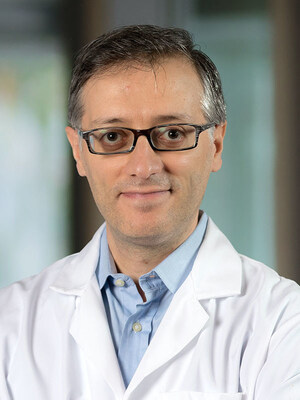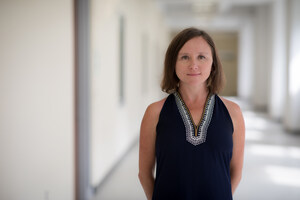BRONX, N.Y., Oct. 9, 2017 /PRNewswire-USNewswire/ -- Scientists at Albert Einstein College of Medicine have discovered the first compound that directly makes cancer cells commit suicide while sparing healthy cells. The new treatment approach, described in today's issue of Cancer Cell, was directed against acute myeloid leukemia (AML) cells but may also have potential for attacking other types of cancers.
"We're hopeful that the targeted compounds we're developing will prove more effective than current anti-cancer therapies by directly causing cancer cells to self-destruct," says Evripidis Gavathiotis, Ph.D., associate professor of biochemistry and of medicine and senior author of the study. "Ideally, our compounds would be combined with other treatments to kill cancer cells faster and more efficiently—and with fewer adverse effects, which are an all-too-common problem with standard chemotherapies."
AML accounts for nearly one-third of all new leukemia cases and kills more than 10,000 Americans each year. The survival rate for patients has remained at about 30 percent for several decades, so better treatments are urgently needed.
The newly discovered compound combats cancer by triggering apoptosis—an important process that rids the body of unwanted or malfunctioning cells. Apoptosis trims excess tissue during embryonic development, for example, and some chemotherapy drugs indirectly induce apoptosis by damaging DNA in cancer cells.
Apoptosis occurs when BAX—the "executioner protein" in cells—is activated by "pro-apoptotic" proteins in the cell. Once activated, BAX molecules home in on and punch lethal holes in mitochondria, the parts of cells that produce energy. But all too often, cancer cells manage to prevent BAX from killing them. They ensure their survival by producing copious amounts of "anti-apoptotic" proteins that suppress BAX and the proteins that activate it.
"Our novel compound revives suppressed BAX molecules in cancer cells by binding with high affinity to BAX's activation site," says Dr. Gavathiotis. "BAX can then swing into action, killing cancer cells while leaving healthy cells unscathed." (See video animation of BAX here)
Dr. Gavathiotis was the lead author of a 2008 paper in Nature that first described the structure and shape of BAX's activation site. He has since looked for small molecules that can activate BAX strongly enough to overcome cancer cells' resistance to apoptosis. His team initially used computers to screen more than one million compounds to reveal those with BAX-binding potential. The most promising 500 compounds—many of them newly synthesized by Dr. Gavathiotis' team—were then evaluated in the laboratory.
"A compound dubbed BTSA1 (short for BAX Trigger Site Activator 1) proved to be the most potent BAX activator, causing rapid and extensive apoptosis when added to several different human AML cell lines," says lead author Denis Reyna, M.S., a doctoral student in Dr. Gavathiotis' lab. The researchers next tested BTSA1 in blood samples from patients with high-risk AML. Strikingly, BTSA1 induced apoptosis in the patients' AML cells but did not affect patients' healthy blood-forming stem cells.
Finally, the researchers generated animal models of AML by grafting human AML cells into mice. BTSA1 was given to half the AML mice while the other half served as controls. On average, the BTSA1-treated mice survived significantly longer (55 days) than the control mice (40 days), with 43 percent of BTSA1-treated AML mice alive after 60 days and showing no signs of AML.
Importantly, the mice treated with BTSA1 showed no evidence of toxicity. "BTSA1 activates BAX and causes apoptosis in AML cells while sparing healthy cells and tissues—probably because the cancer cells are primed for apoptosis," says Dr. Gavathiotis. He notes that his study found that AML cells from patients contained significantly higher BAX levels compared with normal blood cells from healthy people. "With more BAX available in AML cells," he explained, "even low BTSA1 doses will trigger enough BAX activation to cause apoptotic death, while sparing healthy cells that contain low levels of BAX or none at all."
Plans call for Dr. Gavathiotis and his team to see whether BTSA1 will show similar effectiveness when tested on animal models of other types of cancer.
The paper, "Direct activation of BAX by BTSA1 overcomes apoptosis resistance in acute myeloid leukemia," was published October 9 in Cancer Cell. In addition to Dr. Gavathiotis and Mr. Reyna, other Einstein researchers involved in the study were Thomas P. Garner, Ph.D., Andrea Lopez, M.S., Felix Kopp, Ph.D., Gaurav S. Choudhary, Ph.D., Ashwin Sridharan, M.D., Swathi-Rao Narayanagari, M.S., Kelly Mitchell, M.S., Baoxia Dong, Ph.D., Boris A. Bartholdy, Ph.D., Amit Verma, MB.B.S., and Ulrich Steidl, M.D., Ph.D.
Funding for this research was provided by the National Cancer Institute (NCI), part of the National Institutes of Health (R01CA178394), and awards from the Sidney Kimmel Foundation for Cancer Research, the Gabrielle's Angels Foundation for Cancer Research, and the Pershing Square Sohn Cancer Research Alliance. Partial support was also provided by the Albert Einstein Cancer Center, which is funded by the NCI (P30CA013330).
About Albert Einstein College of Medicine
Albert Einstein College of Medicine is one of the nation's premier centers for research, medical education and clinical investigation. During the 2016-2017 academic year, Einstein is home to 717 M.D. students, 166 Ph.D. students, 103 students in the combined M.D./Ph.D. program, and 278 postdoctoral research fellows. The College of Medicine has more than 1,900 full-time faculty members located on the main campus and at its clinical affiliates. In 2016, Einstein received more than $160 million in awards from the National Institutes of Health (NIH). This includes the funding of major research centers at Einstein in aging, intellectual development disorders, diabetes, cancer, clinical and translational research, liver disease, and AIDS. Other areas where the College of Medicine is concentrating its efforts include developmental brain research, neuroscience, cardiac disease, and initiatives to reduce and eliminate ethnic and racial health disparities. Its partnership with Montefiore, the University Hospital and academic medical center for Einstein, advances clinical and translational research to accelerate the pace at which new discoveries become the treatments and therapies that benefit patients. Einstein runs one of the largest residency and fellowship training programs in the medical and dental professions in the United States through Montefiore and an affiliation network involving hospitals and medical centers in the Bronx, Brooklyn and on Long Island. For more information, please visit www.einstein.yu.edu, read our blog, follow us on Twitter, like us on Facebook, and view us on YouTube.
SOURCE Albert Einstein College of Medicine
Related Links
WANT YOUR COMPANY'S NEWS FEATURED ON PRNEWSWIRE.COM?
Newsrooms &
Influencers
Digital Media
Outlets
Journalists
Opted In






Share this article